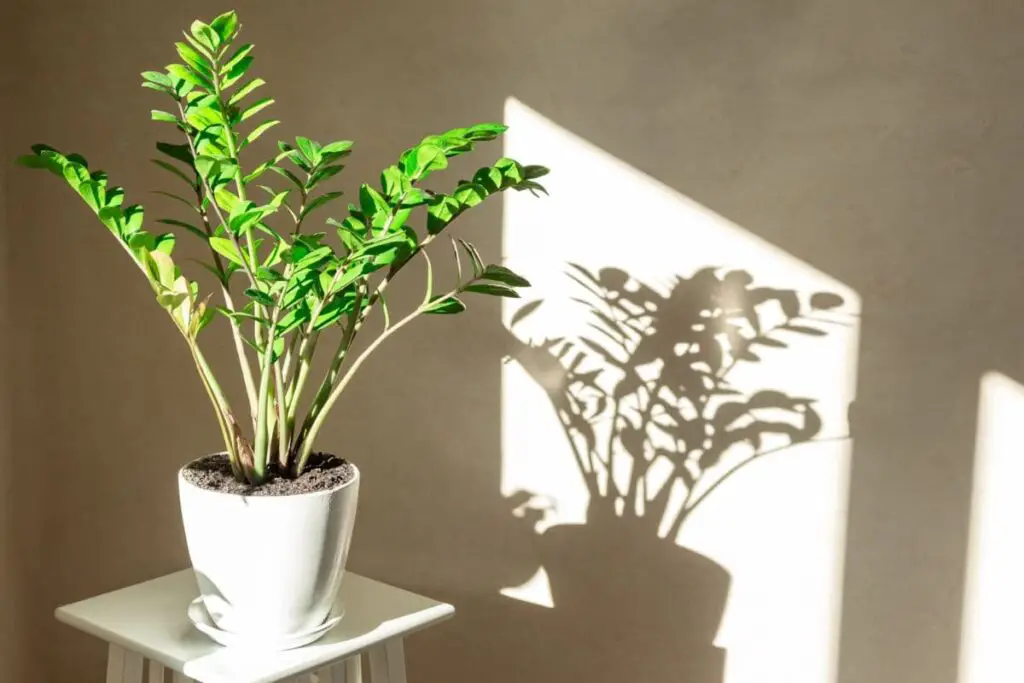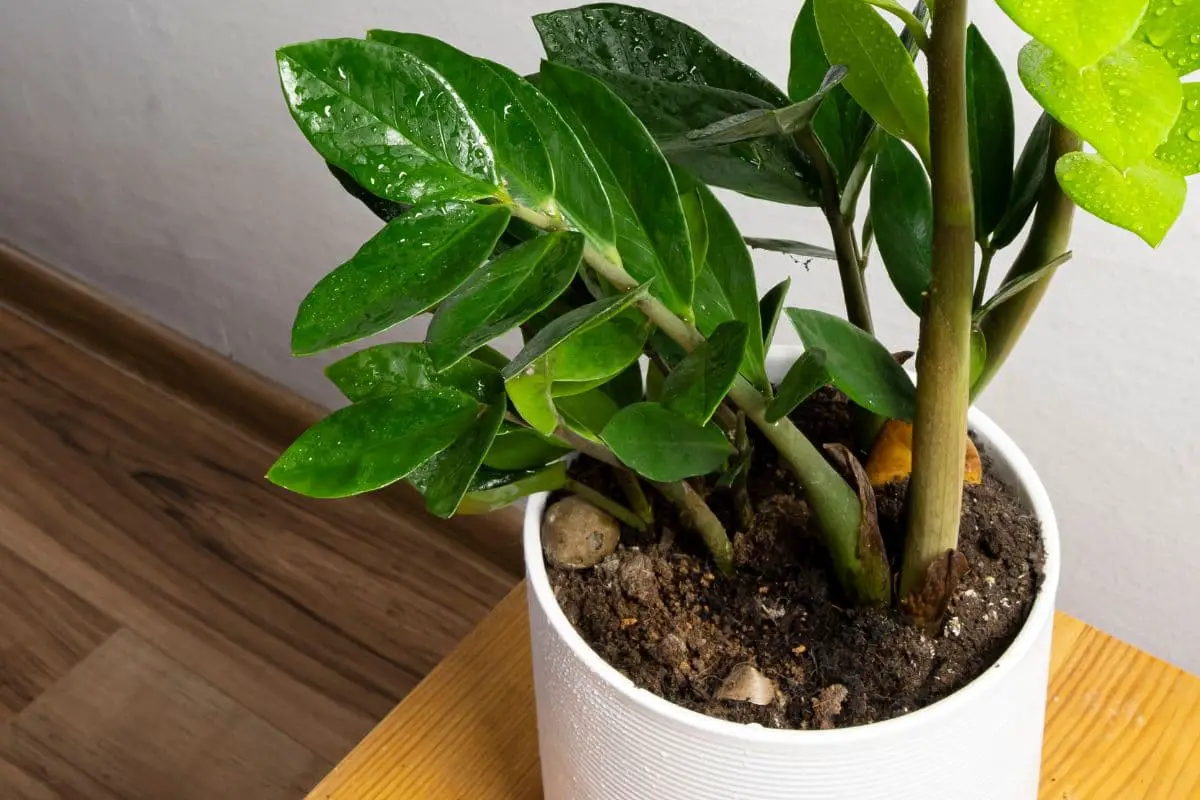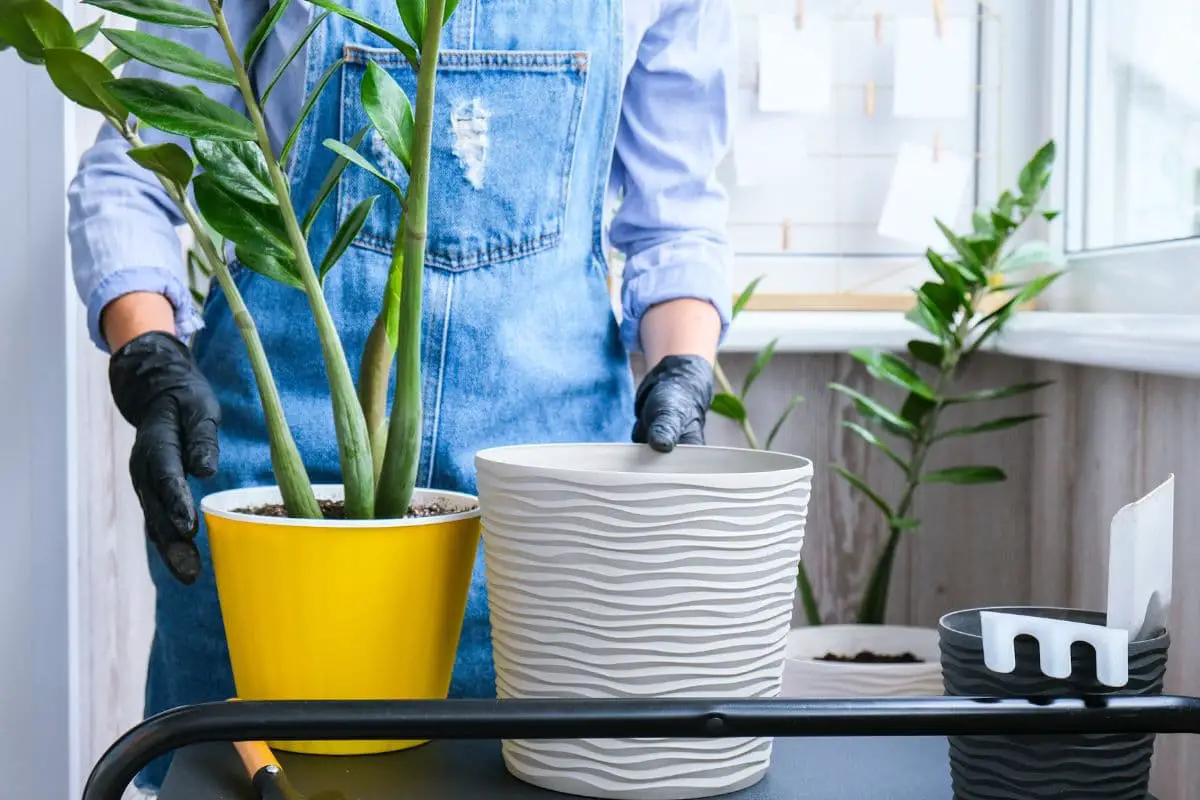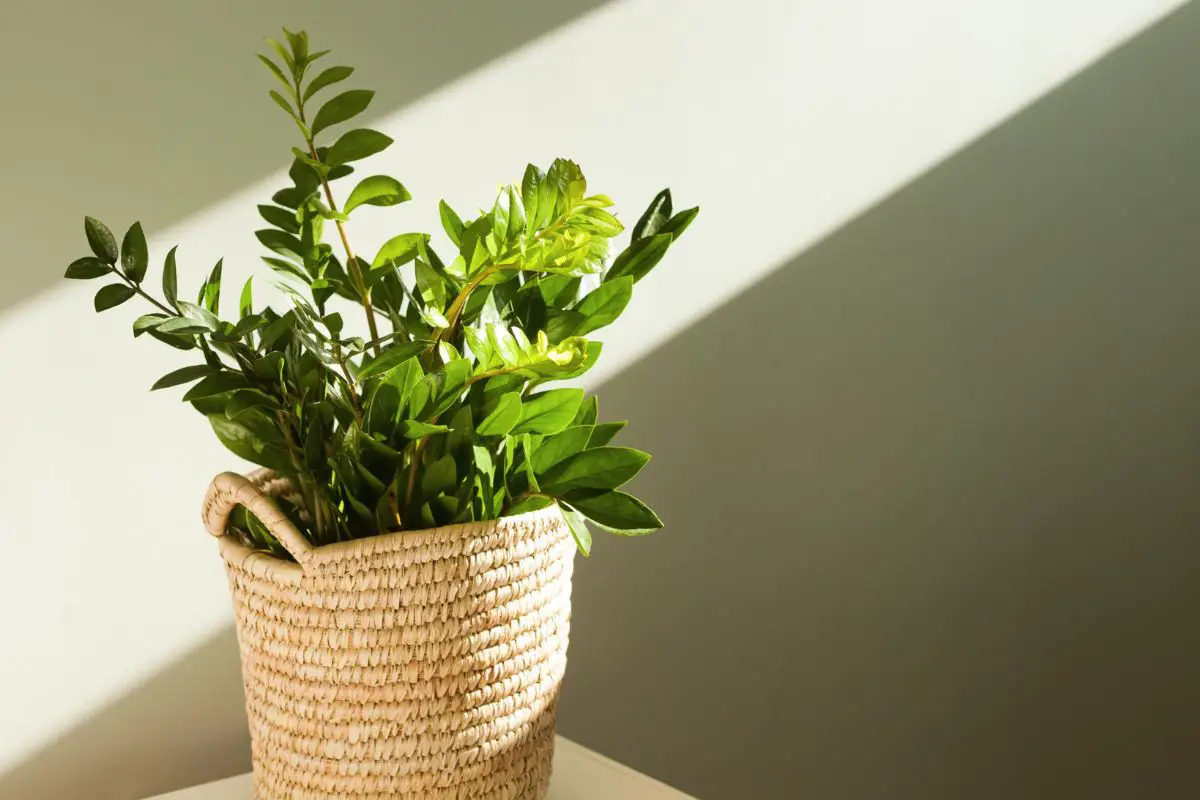ZZ plants are famous for their waxy green leaves and low maintenance needs. The leaves can last several months before naturally fading to yellow. However, they can turn brown prematurely when the plant is stressed.
The factors that cause browning leaves in ZZ plants include the following:
- Underwatering
- Overwatering
- Intense sunlight
- Fertilizer Burn
- Pest Infestation
- Transplant and relocation shock
- Temperature stress
- Improper humidity
In the rest of the article, I’ll explore how these factors affect ZZ plants and turn the leaves brown. I’ll also share practical solutions and preventive measures to ensure your ZZ plant remains healthy.

ZZ Plants: An Overview
ZZ plants (Zamioculcas zamiifolia) are tropical natives from East and South Africa. The loose soil and infrequent rains in the area influenced them to develop efficient moisture absorption and retention properties with their succulent roots, rhizomes, and stems.
The stored moisture can sustain the plant’s needs and keep the leaves fresh and green even during the dry period.
Because of their natural qualities, ZZ plants have become popular in US homes and offices. They’re generally known as tough houseplants to kill because they can bounce back despite being exposed to suboptimal conditions or long periods of neglect.
Even dry-looking rhizomes can sprout if planted and placed in ideal conditions. The shoots, on the other hand, can survive up to 2 months of drought, but their leaves won’t remain attractive if they’re constantly exposed to poor care and environment.
That said, it takes consistent care and attention to keep ZZ leaves green and vibrant.
Symptoms of Browning Leaves
Stressed ZZ plants will show the following symptoms before turning brown:
- Yellow leaf tips
- Yellow spots on the leaf surface
- Drooping or wilting leaves and stems
- White film on the soil surface
- Crusty, cracked soil
When left unaddressed, the symptoms can lead to severe stress. You may also notice the following patterns along with the discoloration:
- Dry and crisp brown tips or sections (leaf scorch)
- Water-soaked lesions or mushy sections
- Yellow margin around tiny, crisp, brown spots
Since browning can indicate a more advanced problem than yellowing, it’s important to detect the issue early on to improve your chances of saving your plant.
Common Causes & Fixes
Several issues can cause brown leaves in ZZ plants. Let’s discuss them below.
Underwatering
Between watering sessions, ZZ plants continue sending moisture to the leaves from the reserves in their potato-like rhizomes and succulent stems. The waxy coating on the leaves also slows down moisture loss through evaporation.
These collective functions help retain the leaves’ green hue.
During extended periods of drought, the moisture supply can be exhausted, and the plant can’t maintain the foliage anymore. The dehydrated leaves gradually droop and turn yellow at the tips before turning brown and crisp. If left untreated for too long, the leaves will eventually fall off.
Frequent underwatering can cause the soil to become hydrophobic as fatty compounds build up around the particles. This can prevent proper moisture uptake even if you water your plant deeply.
You can fix an underwatered ZZ plant with the following tips:
- Wear gloves and pinch the dried leaves. If entire stems have dried out, cut them down to an inch (2.5 cm) above soil level using sterile shears.
- Water the plant deeply to rehydrate the soil completely.
- If the soil has become hydrophobic, soak it in water for around 30 minutes until it’s completely saturated.
- If severely hydrophobic, repot your plant in fresh soil mix and water deeply.
Check the soil 10 days after watering to see if it has dried halfway through. If so, water your plant right away. Avoid waiting for the soil to become bone-dry, as this can lead to hydrophobicity, and the problem will keep recurring.
Overwatering
ZZ plants dislike sitting in wet soil. If the soil is wet or soggy, the plant will go through the following responses:
- The root pressure increases and the moisture goes up to the leaves.
- The leaves will then release the moisture in liquid form through guttation.
- If the evaporation and transpiration rates are too low due to low light and temperature, the excess moisture in the leaves can cause the cells to swell.
- With prolonged turgidity and high root pressure, plant cells can burst.
- The leaves will then develop brown, wet, mushy spots on the surface.
- When severely overwatered, the roots and bulbs suffocate and rot and fail to send moisture up to the shoots.
- The leaves will then start showing signs of dehydration similar to underwatering, such as brown, crisp leaf tips.
When you notice guttation or mushy leaves, reconsider your watering schedule and increase the interval. Wait for the soil to dry out halfway or ⅔ through before watering again. This will prevent more severe symptoms of overwatering.
In case of root rot, you must carefully unpot your plant and prune the damaged roots and bulbs.
Repot your plant in fresh, well-draining soil in a pot that’s only 2 inches (5 cm) wider and deeper than the root ball. Leave an additional space above to keep the bulbs an inch (2.5 cm) below the soil surface.
Pro tip: ZZ plants like to be snug in their spots because they grow slowly, so avoid using too large pots. Moreover, oversized pots hold too much soil, which can increase the risk of overwatering.
Intense Sunlight
ZZ plants grow in shady forests in their native habitat, where they receive dappled sunlight all day. The waxy leaves are sensitive to too much direct sunlight, which can turn them brown and crisp.
Due to the less intense sunlight in the northern hemisphere, ZZ plants can tolerate up to 2 hours of direct morning sunlight. However, you may need to increase the watering frequency, as they lose moisture more quickly under brighter conditions.
Here are some tips to fix sun-damaged ZZ plants:
- Pinch dried or damaged leaves because they won’t recover their green color once they’ve dried up.
- Move your plant away from direct sunlight or hang sheer curtains against the window.
- Place your plant in a spot where it can receive bright, indirect light for 8 hours daily.
- Rotate the pot by 90-180° weekly in brighter conditions or at watering in low-light conditions.

Fertilizer Burn
Excess fertilizer salts in the soil can drain moisture from the roots and bulbs through osmosis. The water from plant cells will naturally move toward the soil, where there’s a higher concentration of salts.
Fertilizers are usually leached from pots through regular top watering. However, the infrequent watering requirement of ZZ plants keeps the salts in the soil for longer. As a result, the shoots are deprived of moisture and nutrients and begin showing signs of dehydration and leaf scorch.
You can confirm fertilizer burn if you’ve recently applied granular fertilizers to the soil and there’s a white film over the surface.
To fix the problem, follow these steps:
- Scrape ¼-½ inch (0.6-1.3 cm) off the soil surface. Be careful not to damage the roots and bulbs.
- Replace the soil with fresh succulent mix or compost-perlite mix.
- Water your plant deeply until you see the excess drip from the drainage holes.
- After an hour or the following day, water your plant deeply again to flush out the remaining salts.
- Leave the pot on a drip tray and the well-draining substrate will release the excess water from the roots.
Pest Infestation
Sap feeders like aphids, mealybugs, and scale mites like the fleshy stems and leaves of ZZ plants. If there’s a large infestation, the pests can puncture tiny holes on leaf undersides.
The wounds will then turn yellow. In rare cases, the damage can worsen and the holes will get bigger with a brown center and yellow margin.
You can treat and manage pest problems with these steps:
- Pick up pests hiding underneath the leaves or along the stems using tweezers or scrape them off using cotton swabs moistened with alcohol.
- Drop them in a cup of soapy water.
- Spray your plant with neem oil solution once a week. You can do it during the day if your plant is in low light or at night if it receives brighter light conditions during the day.
It also helps to treat pest infestations in neighboring plants to prevent recurrence.
Transplant or Relocation Shock
Newly rooted cuttings may experience transplant shock when moved to a spot that’s significantly different from their initial environment.
For instance, moving them to a brighter or sunnier spot will dry out the young leaves faster because the root system and the rhizomes are not yet robust enough to absorb and store enough moisture. As a result, the leaves will turn brown and crisp.
Even mature plants will show relocation shock when suddenly exposed to direct sunlight after being accustomed to shade.
You can fix the issue with these tips:
- Move the plant closer to its initial environmental conditions (i.e., light and temperature).
- Adjust the watering frequency accordingly. If the new spot is brighter and warmer, you may need to water the plant more often, as it will become more metabolically active.
- If you need to relocate the plant for practical or aesthetic reasons, move them gradually. For instance, move them by a foot (30 cm) every 3 days.
Temperature Stress
ZZ plants like warm temperatures around 75 °F (24 °C). They can handle up to 85 °F (29 °C), but they’ll need more frequent watering to keep the leaves hydrated.
Constantly high temperatures can worsen light stress and dehydration in ZZ plants, speeding up the decay or browning of the leaves.
Here are some ways to fix the problem:
- Move your plant away from sunny windows, heating vents, or appliances that generate much heat when in use (e.g., TV or refrigerator).
- Increase the watering frequency accordingly to prevent the leaves from drying out too quickly.
Improper Humidity
Changes in humidity levels normally don’t affect healthy ZZ plants. But if the plant is already stressed due to light, temperature, and watering issues, improper humidity can contribute to how quickly the plant succumbs to the damage.
High humidity can worsen overwatering issues, whereas low humidity can worsen dehydration and leaf scorch. The ideal humidity level for ZZ plants is 40-50%.
You can improve the condition in the following ways:
- Increase the humidity using a humidifier or pebble tray with water. You can also group together plants that thrive in low light.
- Reduce the humidity using a dehumidifier or by switching on an electric fan to improve the air circulation in the room. You may also need to prune unruly stems to prevent overcrowding in your plant’s foliage.
Routine Care and Maintenance
It can take a while before ZZ plants grow fresh and healthy leaves after pruning the damaged foliage and improving your care routine.
Full-grown plants typically produce 1-2 new stalks per month from spring to summer. Each stalk can take up to 4 weeks to reach a good size.
That said, prevention is key to keeping your plant thriving and vibrant. And the best way to avoid plant stress is to have a solid care and maintenance routine.
Here are some care tips to remember to keep your ZZ plant in top shape:
- Grow your plant in loose soil rich in organic matter.
- Repot in a breathable container with drainage holes every 2-3 years. Be sure to use a pot that’s only 2 inches (5 cm) wider and deeper than the rootball.
- Water your plant as soon as the top half of the potting mix is dry during the growing season. In mid-fall and winter, you can reduce watering frequency to every 4-6 weeks.
- Keep your plant in bright, indirect light. Give the pot a quarter or a half turn every time you water your plant for even growth.
- Maintain temperatures between 65 and 85 °F (18 and 29 °C).
- Use high-quality succulent mix or compost in the soil mix for a low dose of nutrients. Fertilize your plant only once (in spring) in the second year after repotting to avoid overfertilization.
- Prune old, yellowing stems down to an inch (2.5 cm) above soil level to allocate the plant’s resources to maintaining the fresh and green growth.
- Dust the leaves or wipe them with a clean, moist cloth once every 2 weeks to remove dirt.
- Inspect the leaves and stems regularly and manually remove pests as soon as you spot them.
Final Thoughts
ZZ plants are resilient and likely to survive heavy pruning of brown or damaged foliage. Unfortunately, it can take them several months of adequate care to replace the leaves they have lost.
It may take a while for beginner gardeners to find the rhythm, but ZZ plants are generally low-maintenance once you find the best spot and watering schedule. Be proactive in your plant care routine to enjoy their beauty for years.
Leave a comment if you have any questions or would like to share your personal experience with ZZ plants. Don’t forget to subscribe for more plant care tips and tricks.







